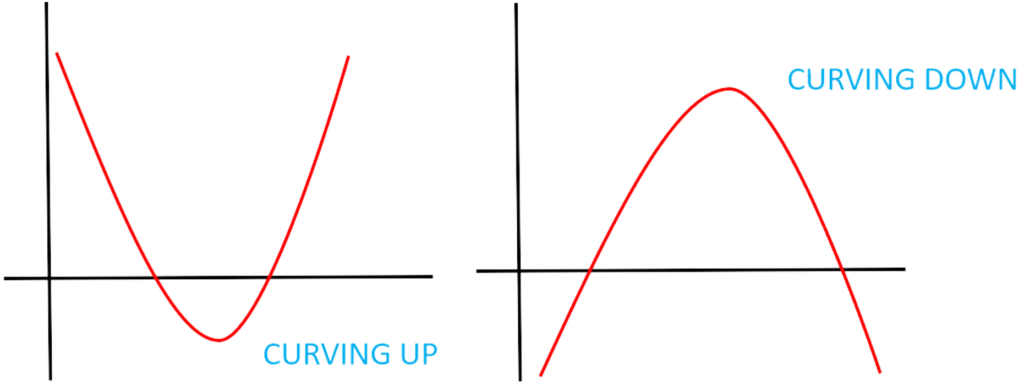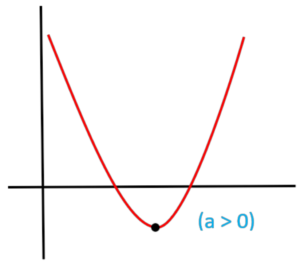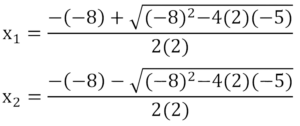Completing the Square: Comprehensive Guide With Worksheet
Completing the Square
What is Completing the Squares?
- Completing the squares is a powerful technique used in algebra to solve quadratic equations.
In this article, we will discuss:
- What is Completing the Squares?
- What are the different applications of Completing the Squares?
- GCSE Past Paper Questions
Here is one more link to practice a few extra questions: Maths Genie Completing the Squares Questions
What is Completing the Square used for?
- Completing the Square involves converting any quadratic equation of the type:
ax2 + bx + c —-> a(x-h)2 + k
It can be used to:
- Find the Turning Point of a Quadratic Equation
- Find the Maximum or Minimum value of a Quadratic Equation
- Solve a quadratic equation and find its roots
Turning Point from Completing the Square
What is the Turning Point of a Quadratic Equation?
- The graph of quadratic equation represents a parabola, which can look something like this: curving either upward or downward

Our goal is to locate the turning point of this parabola.
To illustrate the process, let’s work through a straightforward example:
Solved Example
Question: Find the Turning Point of the Quadratic Equation x2 + 3x – 10
Solution:
- Step #1: Begin with a quadratic equation in standard form, ax2 + bx + c.
For our example, a = 1, b = 3, and c = -10.
- Step #2: Apply Completing the Square to transform it into vertex form.
1. First, factor out the leading coefficient ‘a’ from the first two terms:
x2 + 3x – 10 = 1(x2 + 3x) – 10
2. To complete the square, we need to add and subtract (b/2)2 inside the
parentheses. In this case,
(3/2)2 = 9/4. x2 + 3x + 9/4 – 10 – 9/4
3. Rearrange the equation by grouping the terms:
(x2 + 3x + 9/4) – (40/4 + 9/4)
4. Simplify both sides:
(x + 3/2)2 – 49/4
- Step #3: Rewrite it in vertex form, a(x-h)2 + k.
In our example, a = 1, h = -3/2 (opposite sign), and k = 49/4.
So, the turning point of the quadratic equation x2 + 3x – 10 is (-3/2, 49/4).
Practice Questions
Question 1. Find the turning point of the quadratic equation: x2− 6x + 9
Answer : ( , )Solution:
To find the turning point, we'll complete the square:
1. Factor out the leading coefficient 'a' from the first two terms:
x2 − 6x + 9 = 1(x2 − 6x) + 9
2. Add and subtract (b/2)2 inside the parentheses. In this case, (6/2)2 = 9:
x2 − 6x + 9 - 9 + 9
3. Rearrange the equation by grouping the terms:
(x2 − 6x + 9) - (9 - 9)4. Simplify both sides:
(x - 3)2 + 0
Now, we have it in vertex form, (x - h)2 + k, where h = 3 and k = 0.
So, the turning point of the quadratic equation x2 − 6x + 9 is (3, 0).
Question 2: Determine the turning point of the quadratic equation: x2 + 4x − 4
Answer : ( , )Solution:
To find the turning point, we'll complete the square:
1. Factor out the leading coefficient 'a' from the first two terms:
x2 + 4x - 4 = 1(x2 + 4x) - 4
2. Add and subtract (b/2)2 inside the parentheses. In this case, (4/2)2 = 4:
x2 + 4x + 4 - 4 - 4
3. Rearrange the equation by grouping the terms:
(x2 + 4x + 4) - (4 - 4)4. Simplify both sides:
(x + 2)2 + 0
Now, we have it in vertex form, (x - h)2 + k, where h = -2 and k = 0.
So, the turning point of the quadratic equation x2 + 4x - 4 is (-2, 0).
Exploring Completing the Square with 'a' Not Equal to 1
What happens when the coefficient of x2 is not 1?
- Up until now, we’ve worked with quadratic equations where ‘a’ (the coefficient of x2) was conveniently set to 1.
This simplified the Completing the Square process.
However, quadratic equations in real-world scenarios often have ‘a’ values other than 1.
Let’s tackle a more complex example:
- Step #1: Begin with the given quadratic equation:
2x2 – 8x – 5
- Step #2: To complete the square, factor out the leading coefficient ‘a’ (which is 2 in this case) from the first two terms:
2(x2 – 4x) – 5
- Step #3: Now, we need to add and subtract (b/2)2 inside the parentheses. Here, (4/2)2=4, so we add and subtract 4:
2(x2 – 4x + 4 – 4) – 5
- Step #4: Rearrange the equation by grouping the terms:
2((x2 – 4x + 4) – 4) – 5
- Step #5: Simplify the grouped terms inside the parentheses:
2((x – 2)2 – 4) – 5
- Step #6: Distribute the 2 back into the expression:
2(x – 2)2 – 8 – 5
- Step #7: Simplify further:
2(x – 2)2 – 13
Now, we have successfully completed the square, and the equation is in vertex form, a(x – h)2 + k, where a = 2, h = 2, and k = -13
So, the turning point of the quadratic equation 2x2 – 8x – 5 is (2, -13).
Practice Questions
Question 1. Find the turning point of the quadratic equation: 3x2 − 12x + 10
Answer : ( , )Solution:
To find the turning point, we'll complete the square:
1. Begin with the given quadratic equation:
3x2 − 12x + 10
2. Factor out the leading coefficient 'a' (which is 3 in this case) from the first two terms:
3(x2 − 4x) + 10
3. Add and subtract (b/2)2 inside the parentheses. Here, (4/2)2 = 4, so we add and
subtract 4:
3(x2 − 4x + 4 - 4) + 104. Rearrange the equation by grouping the terms:
3((x2 − 4x + 4) -4) + 10
5. Simplify the grouped terms inside the parentheses:
3(x - 2)2 − 12 + 10
6. Distribute the 3 back into the expression:
3(x - 2)2 − 2
Now, we have it in vertex form, a(x - h)2 + k, where a = 3, h = 2, and k = -2.
So, the turning point of the quadratic equation 3x2 - 12x + 10 is (2, -2).
Question 2: Determine the turning point of the quadratic equation: -2x2 + 8x - 6
Answer : ( , )Solution:
To find the turning point, we'll complete the square:
1. Begin with the given quadratic equation:
-2x2 + 8x - 6
2. Factor out the leading coefficient 'a' (which is -2 in this case) from the first two terms:
-2(x2 − 4x) - 6
3. Add and subtract (b/2)2 inside the parentheses. Here, (4/2)2 = 4, so we add and
subtract 4:
-2(x2 − 4x + 4 - 4) - 64. Rearrange the equation by grouping the terms:
-2((x2 − 4x + 4) -4) - 6
5. Simplify the grouped terms inside the parentheses:
-2(x - 2)2 + 8 - 6
6. Distribute the -2 back into the expression:
-2(x - 2)2 + 2
Now, we have it in vertex form, a(x - h)2 + k, where a = -2, h = 2, and k = 2.
So, the turning point of the quadratic equation -2x2 + 8x - 6 is (2, 2).
Finding Maxima and Minima from Completing the Square
How to find the Maximina and Minima of a Quadratic Equation?
- The concept of maximum and minimum values in the quadratic function represents the highest and lowest points on the parabolic graph formed by the quadratic equation.
- Maximum values occur when the parabola opens downward (a < 0),

- Minimum values occur when it opens upward (a > 0).

Solved Example
Question: Find the Maximum or Minimum Value of the Quadratic Equation 2x2 – 8x + 6
Solution:
- Step #1: Begin with the given quadratic equation:
2x2 – 8x + 6
- Step #2: Factor out the leading coefficient ‘a’ (which is 2 in this case) from the first two terms:
2(x2 – 4x) + 6
- Step #3: Add and subtract (b/2)2 inside the parentheses. Here, (4/2)2 = 4, so we add and subtract 4:
2(x2 – 4x + 4 – 4) + 6
- Step #4: Rearrange the equation by grouping the terms:
2((x2 – 4x + 4) – 4) + 6
- Step #5: Simplify the grouped terms inside the parentheses:
2(x – 2)2 – 8 + 6
- Step #6: Distribute the 2 back into the expression:
2(x – 2)2 – 2
Now, we have it in vertex form, a(x – h)2 + k, where a = 2, h = 2, and k = -2.
In this case, ‘a’ is positive (a > 0), indicating that the parabola opens upward. Therefore, the vertex represents the minimum value.
So, the minimum value of the quadratic equation 2x2 – 8x + 6 is -2, and it occurs at the vertex, which is (2, -2).
Practice Questions
Question 1. Find the maximum or minimum value of the quadratic equation: x2 + 6x + 9
Answer :Solution:
1. Identify 'a' and 'b':
- 'a' (coefficient of x2) = 1
- 'b' (coefficient of 'x') = 6
- Add and subtract (b/2)2:
x2 + 6x + (6/2)2 - (6/2)2 + 9
x2 + 6x + 9 - 9 + 9
3. Rearrange the equation to isolate the perfect square:(x2 + 6x + 9) - 9 = 9 - 9
4. Simplify the grouped terms inside the parentheses:(x + 3)2 − 9 = 0.
5. Now, the equation is in vertex form, a(x − h)2 + k:- 'a' is positive (a > 0), so it's a minimum.
- 'k' is the value -9.
Question 2: Determine the maximum or minimum value of the quadratic equation: -3x2 - 12x - 15
Answer :Solution:
1. Identify 'a' and 'b':
- 'a' (coefficient of x2) = -3
- 'b' (coefficient of 'x') = -12
- Add and subtract (b/2)2:
-3x2 - 12x + (-12/2)2 - (-12/2)2 - 15
-3x2 - 12x + 36 - 36 - 15
3. Rearrange the equation to isolate the perfect square:(-3x2 - 12x + 36) - 36 = -15 - 36
4. Simplify the grouped terms inside the parentheses:(-3(x2 + 4x + 12)) − 36 = -51
5. Now, the equation is in vertex form, a(x − h)2 + k:- 'a' is negative (a < 0), so it's a minimum.
- 'k' is the value -51.
These are the maximum and minimum values for the respective quadratic equations.
Solving Quadratic Equations
- Completing the squares can also be used to find the roots of a quadratic equation.
- Other techniques that can be used is factorisation and quadratic formula.
- To illustrate how Completing the Square can be used for solving quadratic equations, let’s work through an example:
Solved Example
Question: Solve the Quadratic Equation x2 – 6x + 9 = 0
Solution:
- Step #1: Begin with the given quadratic equation:
x2 – 6x + 9 = 0
- Step #2: Express it in standard form, with one side equal to zero:
x2 – 6x + 9 – 9 = 0 – 9
- Step #3: Factor out the leading coefficient ‘a’ (which is 1 in this case) from the first two terms:
(x2 – 6x) + 9 – 9 = -9
- Step #4: Add and subtract (b/2)2 inside the parentheses. Here, (6/2)2 = 9, so we add and subtract 9:
(x2 – 6x + 9 – 9) = -9
- Step #5: Rearrange the equation by grouping the terms:
(x2 – 6x + 9) – 9 = -9
- Step #6: Simplify the grouped terms inside the parentheses:
(x – 3)2 – 9 = -9
- Step #7: Add 9 to both sides to isolate the perfect square:
(x – 3)2 = 0
- Step #8: Take the square root of both sides:
x – 3 = ±√0
- Step #9: Simplify the square root of 0 to 0:
x – 3 = ±0
- Step #10: Solve for ‘x’ by adding 3 to both sides:
x = 3
So, the solution to the quadratic equation x2 – 6x + 9 = 0 is x = 3.
Practice Questions
Question 1. Solve the quadratic equation: 2x2 + 4x - 6 = 0
Answer : ( , )Solution:
1. Begin with the given quadratic equation:
2x2 + 4x - 6 = 0
2. Express it in standard form by rearranging the terms:2x2 + 4x - 6 = 0
3. Divide the entire equation by 2 to simplify:x2 + 2x - 3 = 0
4. To complete the square, add and subtract (b/2)2 inside the parentheses:x2 + 2x + (2/2)2 - (2/2)2 - 3 = 0
5. Rearrange the equation by grouping the terms:(x2 + 2x + 1) - 1 - 3 = 0
6. Simplify the grouped terms inside the parentheses:(x + 1)2 - 4 = 0
7. Add 4 to both sides to isolate the perfect square:(x + 1)2 = 4
8. Take the square root of both sides:x + 1 = ±2
9. Solve for 'x' by subtracting 1 from both sides:x = −1 ± 2
So, the solutions to the quadratic equation 2x2 + 4x - 6 = 0 are:
x1 = -1 + 2 = 1
x2 = -1 – 2 = -3
Question 2: Find the solutions to the quadratic equation: x2 + 8x + 16 = 0
Answer : ( , )Solution:
1. Begin with the given quadratic equation:
x2 + 8x + 16 = 0
2. Express it in standard form by rearranging the terms:x2 + 8x + 16 = 0
3. To complete the square, add and subtract (b/2)2 inside the parentheses:x2 + 8x + (8/2)2 - (8/2)2 + 16 = 0
4. Rearrange the equation by grouping the terms:(x2 + 8x + 16) - 16 = 0
6. Simplify the grouped terms inside the parentheses:(x + 4)2 - 16 = 0
7. Add 4 to both sides to isolate the perfect square:(x + 4)2 = 16
8. Take the square root of both sides:x + 4 = ±4
9. Solve for 'x' by subtracting 4 from both sides:x = −4 ± 4
So, the solutions to the quadratic equation x2 + 8x + 16 = 0 are:
x1 = -4 + 4 = 0
x2 = -4 – 4 = -8
In this case, there are two distinct solutions:
x1 = 0
x2 = -8
Completing the Square GCSE questions
GCSE Past Paper Question 1: Finding the Turning Point
Question: Find the coordinates of the turning point on the curve with the equation
y = 9 + 18x – 3x2. Show all your working.
Solution:
- Step #1: Begin with the given equation:
y = 9 + 18x – 3x2
- Step #2: Express it in standard form by rearranging the terms:
y = -3x2 + 18x + 9
- Step #3: Factor out the leading coefficient ‘a’ (which is -3 in this case) from the first two terms:
y = -3(x2 – 6x) + 9
- Step #4: Complete the square by adding and subtracting (b/2)2 inside the parentheses. Here, (6/2)2 = 9:
y = -3(x2 – 6x + 9 – 9) + 9
- Step #5: Rearrange the equation by grouping the terms:
y = -3((x2 – 6x + 9) – 9) + 9
- Step #6: Simplify the grouped terms inside the parentheses:
y = -3(x – 3)2 – 27 + 9
- Step #7: Further simplify:
y = -3(x – 3)2 – 18
Now, we have the equation in vertex form, a(x – h)2 + k, where a = -3, h = 3,
and k = -18.
The turning point’s coordinates are (h, k) = (3, -18).
So, the coordinates of the turning point on the curve with the equation
y = 9 + 18x – 3x2 are (3, -18).
GCSE Past Paper Question 2: Sketching the Graph
Question: Sketch the graph of y = 2x2 – 8x – 5, indicating the turning point and providing the precise coordinates of any intercepts with the coordinate axes.
Solution:
To sketch the graph of the given equation, let’s first identify the key elements:
the turning point and the intercepts.
Turning Point:
We’ve already found the turning point coordinates in a previous example:
(h, k) = (2, -9).
Intercepts:
To find the intercepts, we set y = 0 and solve for ‘x’ (x-intercepts) or set x = 0
and solve for ‘y’ (y-intercepts).
For x-intercepts (when y = 0):
0 = 2x2 – 8x – 5
We can use the quadratic formula to find the roots:

In this case, a=2, b=−8, and c=−5.
Calculating the roots, we get:

Solving these, we find the x-intercepts:
x1 ≈ −0.68 (rounded to two decimal places)
x2 ≈ 3.18 (rounded to two decimal places)
For y-intercepts (when x = 0):
y = 2(0)2 – 8(0) – 5
y = -5
So, the y-intercept is at (0, -5).
Now, we can sketch the graph with these key elements:
- Turning Point: (2, -9)
- X-Intercepts: (-0.68, 0) and (3.18, 0)
- Y-Intercept: (0, -5)
Plot these points and sketch the parabolic curve. The graph of y = 2x2 – 8x – 5 should resemble a parabola opening upward with the specified features.
Worksheet on Completing the Squares
Question 1: Turning Point: Find the coordinates of the turning point on the curve with the equation:
y = 4 - 8x + 3x2
Question 2: Completing the Square: Convert the following quadratic equation into vertex form (a(x - h)2 + k) by completing the square: y = x2 - 6x + 9
Question 3: Solving Quadratic Equations: Solve the quadratic equation: x2 + 5x - 6 = 0
Question 4: Graph Sketching: Sketch the graph of the quadratic equation y = -x2 + 4x + 3 and label the coordinates of the turning point and any intercepts with the coordinate axes.
Question 5: Solving Quadratic Equations: Solve the quadratic equation: 2x2 - 12x + 18 = 0

